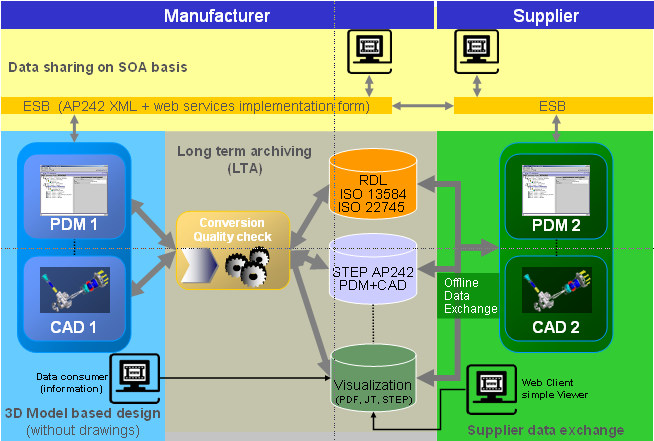The Business Drivers for a convergent AP are based on the following usage scenarios and use cases. Figure 1 gives an overview on the usage scenarios.

3D Model based design
Product design with a 3D master model including all the information typically on technical drawings, e.g. product manufacturing information, within this 3D model in order to avoid technical drawings completely.
Business Driver for Automotive and Aerospace: save efforts for drawing creation and gain efficiency, e.g. for downstream processes, by a unique 3D model based master design that covers all the information. |
|
Supplier integration
| Business Driver for Automotive and Aerospace: the supply chain gains importance (increasing work share and responsibility) for the final product. Therefore an efficient and complete exchange and/or sharing of the product definition based on one standard is important. |
|
Long term archiving
| Business Driver for Aerospace: documentation of Aerospace and defense products have to be available more than 50 years, therefore long term archiving based on 3D model design is a strong requirement. |
|
Data sharing on SOA basis
| Business Driver for Aerospace: the complete support of the product life cycle for design, manufacturing and support in service, e.g. also for exchange with customers (airlines, …) in the service life cycle, is necessary. Therefore the compatibility with STEP AP239 product life cycle support (PLCS) is required. |
|
Engineering Visualization
Business Driver for Automotive and Aerospace: since the number of data consumers is much higher than the number of data creators (internal and external suppliers) an Engineering Visualization strategy based on a lightweight visualization format can save significant license costs for data consumers while increasing the availability of 3D product data for all kinds of applications.
Business Driver for Aerospace: use of one single standard (STEP convergent AP) for the long term archive requires a consistent mapping to a separate performance-optimized visualization format.
(Visualization formats JT, U3D and PRC are considered). |
|
Other usage scenarios, including
- Design to Engineering Analysis
- Design to Manufacturing data exchange
- Design to Manufacturing simulation
- Design to NC planning
- Design to Inspection planning
|
|